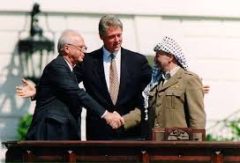Twenty years ago this month, the Arab-Israeli conflict, one of the most protracted and debilitating disputes in the Middle East, finally seemed on the verge of being resolved through peaceful means.
On Sept. 13, 1993, Yitzhak Rabin, the prime minister of Israel, hesitantly shook hands with his arch nemesis, Yasser Arafat, the chairman of the Palestine Liberation Organization, in a solemn ceremony in Washington, D.C. presided over by the president of the United States, Bill Clinton.

Under the Oslo accords, negotiated in secret by Israeli and Palestinian diplomats in Norway and based on United Nations resolution 242 and 338, Israel and the PLO recognized each other and the PLO renounced terrorism.
Oslo called for the creation of an interim self-governing Palestinian entity to be administered by a new body, the Palestinian Authority. The interim period, which was to last for five years, was supposed to lead to a permanent peace agreement by May 1996 and a phased Israeli withdrawal from the West Bank and the Gaza Strip.
Issues to be resolved ran the gamut from final borders and Palestinian refugees to Israeli settlements and security arrangements. Although the accord did not explicitly mention a Palestinian state, it was generally understood that the Palestinians would be granted statehood in the West Bank and Gaza, representing 22% of Palestine.
The historic agreement elicited fierce opposition. Right-wing Israeli political parties, as well as two rejectionist Palestinian factions, Hamas and Islamic Jihad, lambasted it. The Palestinian American scholar, Edward Said, denounced it as “an instrument of Palestinian surrrender.”
However, the majority of Israelis and Palestinians in the occupied territories supported it, believing it would defuse the conflict through a two-state solution, bring prosperity and stabilize the region.
A second Oslo accord, signed in 1995, divided the West Bank into three zones. Area A, consisting of 18% of its land mass, fell under full Palestinian civil and security control. Area B, comprising 21%, is under Palestinian civil control, with Israel and the PA sharing security responsibilities. Area C, where Israeli settlements are located, accounts for 61% of the West Bank.
The Palestinians, therefore, exercise self-rule in only 38% of the West Bank.
For many Israelis, the promise of Oslo began to unravel within a year of its inception. In February 1994, Baruch Goldstein, an American physician living in a West Bank settlement, opened fire on Palestinians in a Hebron mosque, killing 29 worshippers.
In an outpouring of primal rage, Palestinian survivors murdered Goldstein. Hamas suicide bombers exacted still more revenge in a series of brutal attacks that shocked, angered and disheartened Israeli Jews.
Oslo absorbed an additional grievous blow when another Israeli extremist, Yigal Amir, assassinated Rabin in Tel Aviv in November 1995. Rabin, Israel’s chief of staff during the Six Day War and later its ambassador to the United States, was no dove. But as a sober realist, he realized that Palestinian statehood was in Israel’s vital interest if it was to remain a democratic Jewish state.
Rabin’s successor, Shimon Peres, was an ineffectual and unpopular figure. He was defeated in the 1996 general election by Benjamin Netanyahu, the leader of the Likud, which vehemently opposed Palestinian sovereignty in the West Bank and Gaza. Peres’ defeat was generally ascribed to Palestinian terrorism.
The cycle of violence escalated after Israel killed an expert Palestinian bomb maker, Yahya Ayyash, a member of Hamas’ armed wing. His assassination, in January 1996, led to more Palestinian suicide strikes, which, in total, claimed the lives of more than 1,000 Israelis.

As a result of intense Israeli pressure, the PA cracked down on Hamas, but the spirit of cooperation dissipated as Israel expanded settlements and built new neighborhoods in eastern Jerusalem, which the Palestinians claim as their future capital.
In retrospect, the PA regarded its decision to negotiate with Israel while settlements were springing up as a cardinal error. In fact, Israeli settlements violated the spirit but not the letter of Oslo.
Further disillusionment with Oslo occurred when the new Israeli prime minister, Ehud Barak, failed to reach a final status agreement with Arafat at the Camp David summit in the summer of 2000.
This setback proved to be catastrophic, hardening Palestinian public opinion and paving the path to the second intifada, or Palestinian uprising. The rebellion, which broke out two months after Barak and Arafat hit an impasse at Camp David, was far bloodier than the first one.
The pace and scope of suicide bombings increased significantly, prompting Israel to reconquer Palestinian towns in the West Bank in Operation Defensive Shield in the spring of 2002. Concomitantly, Israel stepped up its campaign of assassinating leaders and key operatives of the intifada.
The mounting fatalities sustained by Israel in random suicide attacks disillusioned many Israelis with the sputtering peace process and deepened the level of mistrust of Arafat and Palestinian intentions.
The intifada notwithstanding, the PA won neither hearts nor minds in Israel by tolerating extremism and tacitly encouraging anti-Israel incitement in Palestinian schools, newspapers and TV and radio stations. The accession of a moderate Palestinian president, Mahmoud Abbas, did not make much of a difference to most Israelis.
Barak’s successor, Ariel Sharon, unilaterally withdrew from Gaza in 2005, but Hamas’ violent seizure of Gaza in June 2007 led to an upsurge of bombardments against Israeli communities adjacent to the border. This reign of terror, plus the Gaza war that erupted at the end of 2008, pushed still more Israelis rightward and made compromise all the more difficult.
Netanyahu’s reelection in 2009 only worsened matters, widening the gulf between Israel and the PA and rendering Oslo nearly irrelevant.
Olso has been battered repeatedly in the past two decades, but it remains an integral force in Israel’s often contentious relationship with the Palestinians. The PA, whatever its deficiencies, continues to represent Palestinian interests in the West Bank, Israel, the Arab world and at the United Nations. Palestinian security cooperation with Israel, a pillar of stability, is directed and coordinated by the PA. Thanks to economic agreements signed by Israel and the PA since Oslo, there is a thriving import-export trade.
Oslo, in some respects, has been an abject failure. It has not shatterered the untenable status quo in the West Bank, nor has it given the Palestinians their long-deserved objective of statehood. It has not established genuine trust between Israel and the PA or Israelis and Palestinians. But pragmatically, Oslo has been of some value to both sides in preserving a measure of predictability in conflict management.
